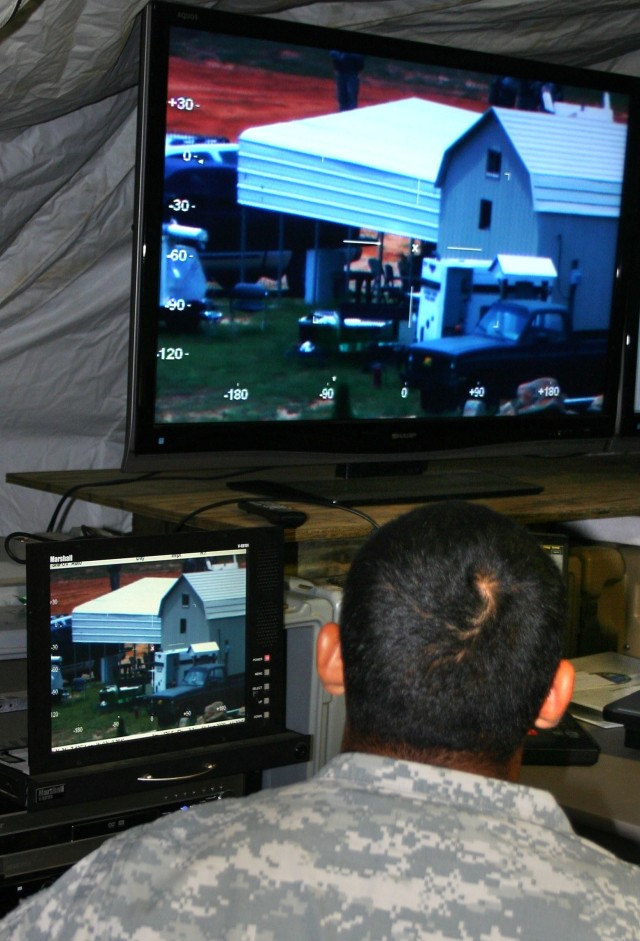FORT POLK, La. (Army News Service, Aug. 19, 2008) - A base defense operations center (BDOC) responsible for monitoring the security of a U.S. forward operating base (FOB) spots an unknown civilian pickup truck that suddenly stops just outside of their perimeter and begins lobbing mortars at personnel within the FOB.
The BDOC crew sounds an acoustic alarm notifying all personnel to take cover. At the same time, the BDOC forwards information about the attack to the brigade tactical operations center, which deploys its quick reaction force and eliminates the threat without any friendly casualties.
This event isn't taking place in Iraq or Afghanistan; it is part of the training at the Joint Readiness Training Center (JRTC) here. Focused on improving the force protection capabilities of military units preparing to deploy into combat, JRTC conducts the training with assistance from the Army's Counter-Rocket, Artillery, Mortar (C-RAM) Program Office, located in Huntsville, Ala., and U.S. Joint Forces Command's (USJFCOM) Joint Fires Integration and Interoperability Team (JFIIT).
"The C-RAM initiative at JRTC has made significant strides in improving the force protection training for Army brigade combat teams (BCTs) as they prepare for eventual deployments to Iraq and Afghanistan," said Navy Lt. Cmdr. Chris Olson, C-RAM project lead at JFIIT. "The great training that JRTC and the C-RAM Program Office provides here will continue to lay the foundation for success. This training provides the maneuver commander with another tool to defeat the perimeter threat that we see today in theater."
Part of this enhanced force protection capability, the Integrated Base Defense System of Systems (IBDSoS), integrates multiple systems and sensors to improve situational awareness and provides an audible warning of a potential attack on an FOB.
"IBDSoS provides the FOB commander with an integrated set of capabilities that is designed to protect against and defeat perimeter threats," said Mitch Rosiere, senior IBDSoS trainer at JRTC. "IBDSoS is an integral part of C-RAM and provides the ground commander with additional capabilities to help defeat the insurgent threat and prevent loss of life."
JFIIT, in support of the C-RAM Program Office, is working to improve the integration of IBDSoS into existing joint fires and joint intelligence, surveillance, and reconnaissance (JISR) capabilities to increase the force protection of U.S. and coalition FOBs.
The C-RAM Program Office has been providing IBDSoS support here since September 2005 and, with assistance from JFIIT, plans on using current IBDSoS capabilities to enhance joint fires and JISR integration to fully maximize base defense training at this and other combat training centers.
"The IBDSoS training that we've received here has been outstanding," said Sgt. Kijan Edwards, BDOC noncommissioned officer in charge from the 3rd Brigade Combat Team, 82nd Airborne Division, Fort Bragg, N.C. "Our ability to immediately get eyes on a potential threat allows us to provide immediate early warning of a potential attack to personnel on the FOB and that helps us save lives."
According to Olson, "Fully incorporating all the joint assets into IBDSoS training, also means improving the ability to provide early warning to personnel located on the FOBs and give forces time to take appropriate actions and defeat this type of irregular warfare threat. Eventually, we will digitally integrate IBDSoS and C-RAM system information with joint fires and command and control systems that will greatly improve shared situational awareness among coalition forces and make it easier to defeat FOB threats."
"Our ability to integrate joint assets with our own fires capabilities cuts down on the time to gain a positive identification on a threat and that helps us to respond quickly and appropriately," said Edwards. "IBDSoS provides us with a mission-essential capability that will give our unit an unprecedented level of force protection once we deploy in theater."
"IBDSoS training is another opportunity for BCTs to receive realistic and rigorous training that prepares them for their next mission," said Rosiere. "The goal of IBDSoS training here is to provide units with the exact tools and capabilities that they will have once deployed. When the maneuver commander knows that he can reach out and fully leverage this system, it will increase their force protection and help them save lives. The more units can learn about this system before coming here to train, the better they will be able to leverage its capabilities once deployed in combat."


Social Sharing